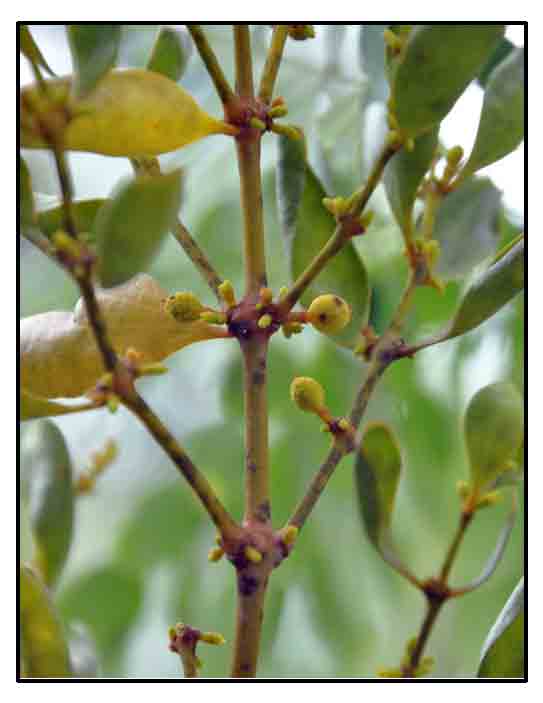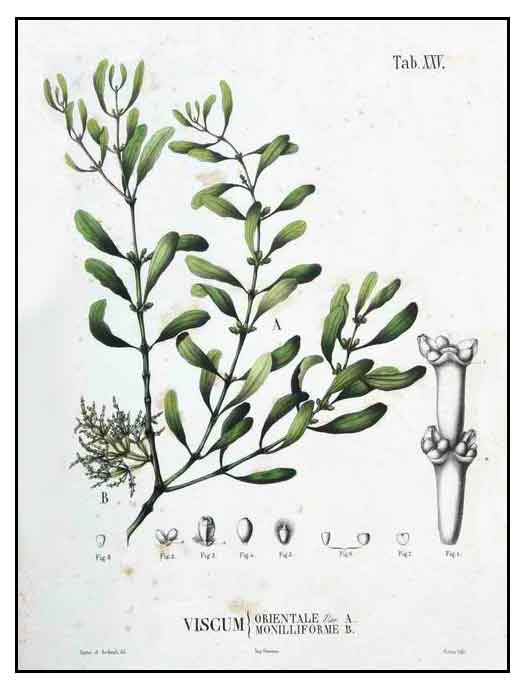 Snippet Snippet
A mistletoe is a parasitic flowering plant that attaches to the stem of another plant (usually gymnosperms and angiosperms). There are about 150 species of Viscum worldwide. They are included in the mythology of some ancient and contemporary cultures. Ecological evidence suggests that while some mistletoes are harmful pathogens, in some cases, they may be keystone species in many forests of the world. (8)
Botany
Botgo is a rather, slender, strongly branched, stem-parasitic shrub. Leaves are opposite, with the petiole not distinguishable from the blade, lanceolate to roundish obovate, up to 8.5 centimeters long, 3.5 centimeters wide, and obscurely 3- to 5-nerved, the base obtuse or rounded, or somewhat wedge-shaped. Flowers are few or many, in stalkless or short cymes, of which the middle flower is female and 1.5 to 2 millimeters long, and the lateral ones, male. Fruit is roundish-ellipsoidal, up to 5 millimeters long, 4 millimeters in diameter, smooth, and yellowish or brownish-green.
Distribution
- Found In Benguet to Quezon Provinces in Luzon; in Lubang; and in Palawan.
- Parasitic on various species of trees at low and medium altitudes.
- Also occurs in India to southern China and southward to Australia.
- Common on dyer's oleander (Wrightia tinctoria) trees, growing in almost all districts of Tamil Nadu and Indo-Malaysia. (4)
 Constituents Constituents
- Phytochemical screening of chloroform and alcohol extracts of aerial parts yielded carbohydrates, phytosterols, triterpenes, and flavonoids. (4)
- Study of methanol extract of leaves yielded five polyphenolic compounds viz., gallic acid, vanillic acid, caffeic acid, ellagic acid, and quercetin at 17.54, 8.99, 99.61, 4523.31, and 100.15 mg/100 g dry weight, respectively. Total phenolic content was 73.4 mg gallic acid equivalent/g of extract, while flavonoid content 170.7 mg quercetin equivalent/g of extract. (see study below) (5)
- Phytochemical screening of methanol extract yielded tannin, phenols, alkaloids, and flavonoids. (6)
Properties
- Plant considered poisonous.
- Considered to possess medicinal properties more or less similar to those of the tree on which it grows.
- Studies have suggest antibacterial, antinociceptive, antioxidant, and CNS depressant activities.
Parts used
Leaves.
Uses
Folkloric
- Plant considered poisonous; in India used as a substitute for nux-vomica.
- Used for pustular itches. Leaves are burned to ashes which are then mixed with sulphur and coconut oil, and rubbed on the body.
- In India's Kalahandi district of Orissa, V. orientale is used with the host plant: Fruits are ground together with equal quantities of the host plant and made into small pills, one pill is taken daily every morning for 4-5 days for giddiness and stiffness. (2)
- In Bangladesh, poultice of leaves used for neuralgia.
- In India, plant juice put in ear to cure pus formation; paste of whole plant in cow's milk used for bloody dysentery; plant ash used to treat ear ache; paste of stem and leaves used to induce abortion. (9)
Studies
• Antibacterial: In a study of aqueous extracts of 46 plants, Viscum orientale was one of 12 plants that exhibited antibacterial activity. Viscum orientale was effective against all test bacteria except E. coli, P. aeruginosa, P mirabilis and Strep faecalis. (1)
• Antioxidant / Antinociceptive / CNS Depressant Effects / Leaves: Study of methanol extract of leaves showed strong dose-dependent free antioxidant activity with IC50 6.63 µg/ml, compared with ascorbic acid with IC50 1.91 µg/ml). Antinociceptive activity in acetic acid and formalin induced pain models in mice was significant (p0.001), and 65.6 and 88.8% writhing inhibition at 300 and 500 mg/kbw, respectively. Overall behavioral testing showed significantly reinforced CNS depressant activity. Spontaneous motor activities were reduced (p<0.05) in both hole cross and open field tests compared to diazepam. (5)
• Cytotoxicity Towards Breast Cancer Cell Lines / Anti-Inflammatory: Study evaluated six species of plants belonging to the Viscaceae family i.e., Viscum orientale, V. nepalense, V. ramosissimum, V. trilobatum, V. angulatum, V. capitallatum, and V. trilobatum for cytotoxicity, anti-tumor, and anti-inflammatory activities. V. orientale produced 30% reduction in paw edema induced by carrageenan and 39% reduction in paw edema induced by dextran. Levels of various pro-inflammatory cytokines (TNF-α, IL-1ß, IL-6, and CRP) and NO markedly increased by carrageenan were significantly reduced by V. orientale. It was also one of four Viscum species that showed cytotoxicity towards four types of human breast cancer cell lines. All six species showed considerable anti-tumor activity against EAC (Ehrlich Ascites Carcinoma) cell induced ascites tumor, and one of four species that reduced solid tumor induced by DLA (Dalton's Lymphoma Ascites) cells. (7)
Availability
Wild-crafted.
|

![]()




 Constituents
Constituents